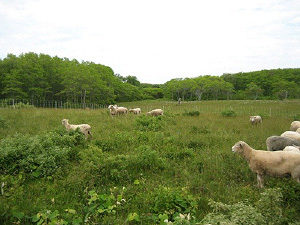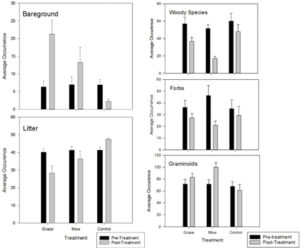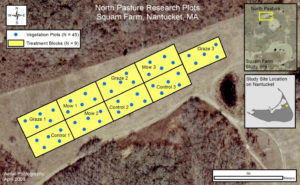Grazing at Squam Farm

Figure 1. Squam Farm sheep grazing experiment. Photo Credit: Nantucket Conservation Foundation.
Squam Farm is a 34-hectare (85-acre) property owned by Nantucket Conservation Foundation (NCF), located on the glacial moraine in the northeastern section of Nantucket. Squam Farm provided an ideal location for a long-term sheep grazing project because it had regulated vehicle access, an accessible water source, and an NCF staff member living on-site year-round.
The cessation of agriculture in the 1800s initiated ecological succession on Squam Farm. Today, the property contains a high level of habitat heterogeneity, including coastal shrubland, managed grassland, deciduous hardwood swamp, mixed deciduous forest, and shrub swamp. Prior to NCF purchasing the land, some upland areas were mowed and grazed with heritage breed livestock during the 1980s and 1990s. As a result, some areas remain open and contain a diverse mixture of graminoids, forbs, vines, and shrubs. After purchasing the land, NCF mowed annually to maintain grassland habitat in these areas.
Prior to this sheep grazing project, vegetation communities contained an assemblage of native sandplain grassland-associated species including little bluestem (Schizachyrium scoparium), Pennsylvania sedge (Carex pensylvanica) and poverty-grass (Danthonia spicata), as well as non-native, cool-season grasses such as velvet-grass (Holcus lanatus), sweet vernalgrass (Anthoxanthum odoratum), and sheep-fescue (Festuca ovina). Common forbs included grass-leaf flat-topped goldenrod (Euthamia graminifolia), common St. Johns-wort (Hypericum perforatum), oxeye-daisy (Leucanthemum vulgare), common sheep sorrel (Rumex acetosella) and dwarf cinquefoil (Potentilla canadensis). These grasslands were interspersed with both native and non-native shrub and vines, including scrub oak (Quercus ilicifolia), small bayberry (Morella caroliniensis), black cherry (Prunus serotina), winged sumac (Rhus copallinum), Japanese honeysuckle (Lonicera japonica), fox-grape (Vitis labrusca) and poison-ivy (Toxicodendron radicans). Further, high population densities of turtles and snakes were observed in upland areas on the property, including rare spotted turtle (Clemmys guttata). Thus, sheep grazing was initiated at this site as an alternative to mowing during the growing season because of potentially less impact on wildlife.
Goals
- Maintain open grassland structure;
- Increase sandplain grassland target species;
- Reduce woody shrub and vine cover;
- Reduce non-native invasive species cover;
- Minimize negative impacts to key wildlife species;
- Test the feasibility of implementing a long-term grazing program.
History
Targeted grazing management occurred at Squam Farm from 2005 to 2015 on approximately 31 hectares (75 acres) of previously-mowed uplands on the property. A targeted research project (Schlimme 2006) occurred within a 0.69 hectareha (1.7 acre) area in 2005 to 2008. At this time, grazing was the primary management tool.
During a ten-year period, a variety of sheep breeds were managed year-round at Squam Farm. During the winter, sheep were kept in permanent fenced pastures in the southern section of the property and fed both grain and purchased or locally-grown hay. Selected ewes were bred in the late fall to produce lambs in mid-April. The initial sheep flock consisted of Cotswold, Romney, and Romney/Cotswold crossbreeds and was supplemented in 2010 with 15 North Country Cheviot/Scottish Blackface crossbreeds.
Uplands formerly maintained by annual mowing received repeated grazing each year, beginning in early spring (as soon as green-up occurred) and continuing until the first killing frost of late fall. Anecdotal observations and photo monitoring conducted in these areas showed a marked decrease in woody species and a corresponding increase in graminoids over time with this management. In addition to these managed grassland sites, areas containing dense shrubland habitat with non-native, invasive woody species such as Japanese honeysuckle, autumn-olive (Elaeagnus umbellata), privet (Ligustrum spp.), oriental bittersweet (Celastrus orbiculatus) and Amur peppervine (Ampelopsis glandulosa) were also intensely grazed. This treatment was effective at removing the dense shrub understory and facilitating access for follow-up invasive species management.
Grazing at Squam Farm was discontinued in 2015 primarily because of lack of funding, and because of difficulties in maintaining animals year-round.
Research
A research project took place within a 0.69 ha (1.7 acre) section of the North Pastures section of Squam Farm from 2005 to 2008. The experiment examined the effects of repeated grazing and mowing on early successional vegetation composition over a four-year period (3 years of treatment and 1 year of recovery), and compared that treatment to unmanaged control areas (Beattie et al. 2017, Schlimme 2006).
The North Pasture research area was divided into nine research blocks (each 33 m x 21 m) and included 3 Graze, 3 Mow and 3 Control treatments (the Control provided an example of currently unmanaged vegetation as influenced by previous management). Vegetation community composition was sampled within 45 permanently marked 1m2 research plots (5 plots per research block; 15 plots per treatment type) using a 1 m2 inclined point quadrat sampling frame. Sheep used for the project included 28 adult Cotswold sheep during the first (2005) season and a mixed, reduced sized flock of Cotswolds and Romneys during 2006 and 2007.
During each Graze treatment, the sheep remained within the first research block until they had consumed almost all available forage, then were moved to the second and third blocks and allowed to graze for the same period of time. The Mow treatment was performed within 1 to 2 days from when the sheep were removed from the Graze treatment blocks. The number (2 or 3) and timing (month) of treatments varied between each treatment year because of variations in vegetation response. No treatments were conducted during 2008 but post-project vegetation monitoring was done.
Vegetation composition was classified by functional group (graminoid, forb, woody species), and ground cover (bare ground, litter), and quantified using cover classes. Prior to treatments, no significant difference was observed between cover of functional groups and ground cover, allowing comparison of functional groups between treatment blocks.
After three consecutive years of treatment, shifts in functional group and ground cover dominance were evident in the initial year of recovery (2008) in both graze and Mow treatments compared with the control treatment and with pre-treatment. Graze and mow treatments significantly reduced cover of woody species. The Mow treatment showed significantly greater reduction in woody species compared with the Graze treatment. Graminoid occurrence was significantly greater in the Graze and Mow treatments compared with the Control, although only the mow treatment was significantly higher as compared with pre-treatment.
Overall forb species decreased in both the Graze and Mow treatments, although there was no significance between the treatments or pre-treatment forb occurrence.
Both Graze and Mow treatments significantly increased the presence of bare ground in the sampled plots, as compared to the Control and pre-treatment sampling. In the Graze treatment, bare ground was significantly higher at the end of the study compared with the mow treatment. Treatments had little impact on the occurrence of litter, although the Graze treatment showed a non-significant trend of decreased litter.

Figure 3. Pre- and post-treatment results of ground cover and cover of vegetation by functional group.
Individual species of management interest (including three sandplain grassland-indicative species, three weedy/agricultural species, and two woody species) were analyzed separately for trends in response to treatment. Significant changes in three of the eight species were detected after three consecutive years of management. Grassleaf flat-topped goldenrod (Euthamia graminifolia), a sandplain grassland-indicative species, decreased significantly in both the Mow and Graze treatments compared with the control and pre-treatment. The occurrence of sweet vernalgrass, a non-native pasture grass—significantly increased in the Mow treatment compared with both the Graze and Control treatments. Velvet-grass (a non-native, invasive grass) occurrence significantly increased in both the mow and graze treatments compared to the control and pretreatment. The other species examined were ox-eye daisy (Leucanthemum vulgare), Pennsylvania sedge (Carex pensylvanica), little bluestem (Schizachyrium scoparium), scrub-oak (Quercus ilicifolia), and Japanese honeysuckle (Lonicera japonica), and all showed no significant changes between treatments.
Three consecutive years of sheep grazing or mowing treatments significantly decreased the woody species and increased graminoid species. Grazing alone significantly increased patches of bare ground within the landscape, providing areas for seed germination and species recruitment in the grasslands.
Although mowing and grazing had similar effects on reducing woody species occurrence and increasing graminoid cover, the ecological impacts of each treatment varied. Mowing reduced all vegetation to a uniform height, including new leaf and shoot growth as well as older woody stems. In contrast, grazing was selective and sheep tended to prefer newer growth and prune the younger foliage and stems. In this study, the Graze treatment created a patchy mosaic effect, and the amount of time spent in each grazing treatment block influenced the efficiency of treatment.
Ultimately, disturbance by both grazing and mowing treatments increased weedy species in the treatment area. Mowing increasing sweet vernal grass (Anthoxanthum odoratum) significantly more than grazing. Management treatments implemented in areas that have not been recently mowed or grazed should be monitored for the establishment and spread of these weedy species. Mowing and grazing treatments significantly reduced the occurrence of grass-leaf flat-topped goldenrod, a native perennial forb. Management resulting in a mosaic of treatment time and intensity may be more effective at maintaining the suite of native forb species.
The overall conclusions from this study and experiences at Squam Farm were that: (1) sheep grazing reduced clonal shrub and vine cover, (2) grazing also introduced seeds of weedy agricultural plant species, and that grazing alone will not likely result in habitat restoration over a relatively short period of time. Constraints of costs and the difficulty of managing animals year-round led NCF to end the sheep grazing program.
References
Beattie, K.C., Karberg, J.M., Omand, K.A., & O’Dell, D.I., 2017. Sheep grazing as a grassland management tool: Lessons learned on Nantucket Island, Massachusetts. Northeastern Naturalist 24: 45-64.
Schlimme, K.S. 2006. Returning sheep to the island of Nantucket: a conservation experiment at Squam Farm. Unpublished thesis. Duke University, Durham, NC.


